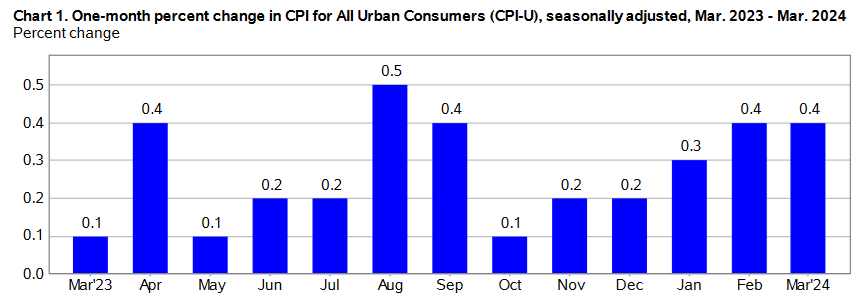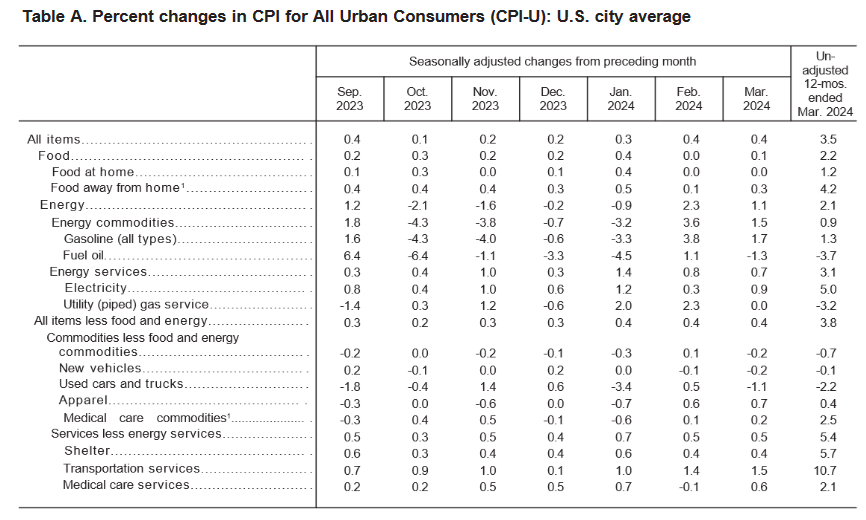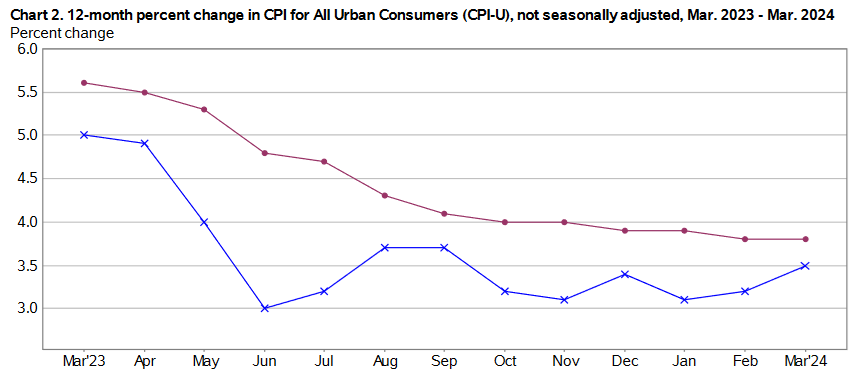The March 2024 Consumer Price Index of All Urban Consumers (CPI-U) report indicates that inflation rose by 0.4% for the month, matching the price acceleration seen in February (+0.4%). These data were released at 8:30 am EST on Wednesday, April 10, 2024, by the Bureau of Labor Statistics. Before seasonal adjustment, the year-over-year (Y-o-Y) inflation rate in the all-items index grew by 3.5%, which is an acceleration from February’s 3.2% Y-o-Y CPI reading.
According to CNBC, economists surveyed by Dow Jones had expected a 0.3% monthly gain and a 3.4% Y-o-Y increase, meaning the March results exceeded Wall Street’s expectations. Given the sticky price pressures and the U.S.’s economic resilience, the data emboldened Fed officials to preach patience as it relates to potential rate cuts.
The Federal Reserve’s federal funds rate sits at 5.25% to 5.5%, which has pushed mortgage and credit card interest rates to multi-year highs. The development has also occurred alongside record U.S. government and consumer credit card debt. However, the U.S. economy remains supported by near-record-low unemployment and above-trend GDP growth.
Global markets had a mixed response to the CPI print, with Europe’s Stoxx 600 index ending the day in positive territory, while U.S. markets sold off.
March’s headline inflation outperformance was driven by higher gasoline prices (+1.7%), transportation services (+1.5%), electricity (+0.9%), and apparel (+0.7%). Core inflation (which excludes the impacts of food and energy), rose 0.4% in March, matching the upticks from January and February. The primary contributors were shelter, motor vehicle insurance, medical care, apparel, and personal care.
Source: Bureau of Labor Statistics
Food Prices
The food index rose 0.1% in March, surpassing February’s reading. Conversely, the food at home index remained flat for the second consecutive month. Three of the six major grocery store food group indexes declined in March, with the cereals andbakery products index showcasing its largest one-month seasonally-adjusted decrease since the BLS began tallying the data in 1989:
- Cereals and bakery products (-0.9%)
- Meats, poultry, fish, and egg (+0.9%)
- Dairy and related products (-0.1%)
- Fruits and vegetables (+0.1%)
- Nonalcoholic beverages (0.3%)
In addition, food away from home rose by 0.3% in March, which annualizes to 3.67%. As a result, restaurants demonstrated resilient pricing power during the month.
Energy Prices
Turning to the energy complex, the index rose +1.1% in March, a material deceleration from the 2.3% rise in February. This month’s uptick was largely driven by higher gasoline and electricity prices, partially offset by a drop in fuel oil prices.
Core March 2024 CPI
The March core CPI rose by 0.4% month-over-month, mirroring the increases from January and February. On a Y-o-Y basis, the metric rose +3.8%. Below is an itemized breakdown of the main price fluctuations seen in the core CPI reading:
- Shelter index: (+0.4%) [February: +0.4%]
- Rent index: (+0.4%) [February +0.5%]
- Owners’ equivalent rent: (+0.4%) [February: +0.4%]
- Motor vehicle insurance: (+2.6%) [February: +0.9%]
- Medical care services: (+0.6%) [February: -0.1%]
- Physician services: (+0.1%) [February: -0.2%]
- Hospital services: (+1.0%) [February: -0.6%]
- Airline fares: (-0.4%) [February: +3.6%]
Source: Bureau of Labor Statistics
Seasonally Unadjusted CPI Data for March 2024
Before seasonal adjustments, the CPI-U for March 2024 increased (+3.5%) Y-o-Y, rising to an index level of 312.332. Since these figures are unadjusted, they include regular seasonal price fluctuations that can create volatility in the results.
Source: Bureau of Labor Statistics
Gold Keeps Shining Despite Higher Interest Rates
Even with Treasury yields, a strong U.S. dollar, and real (inflation-adjusted) interest rates marching higher, gold has maintained its reputation as an inflation hedge. Moreover, with geopolitical tensions increasing its appeal, the yellow metal has more than rate-cut enthusiasm supporting its ascent.
Although forecasts of the first cut moved from March to September, Wall Street analysts still expect the Fed to ease monetary conditions to support the housing market and indebted consumers.
Consumer confidence has taken a noticeable hit recently, as The Conference Board and University of Michigan’s metrics highlight an environment where Americans worry about the cost of living and housing affordability. However, with lower interest rates supporting consumers’ wallets at the expense of higher inflation, the Fed has a tough challenge on its hands.
As the drama unfolds, market participants have pushed assets like gold, silver, and cryptocurrencies like Bitcoin and Ethereum to cycle highs, further emphasizing uncertainty over the Fed’s ability to control inflation.
Furthermore, with stocks near record highs and investors worried about the safety of the U.S. dollar, cash seems less appealing than it once was, even with short-term bonds offering yields near 5%.
Are you thinking about diversifying into precious metals? Talk to your financial advisor about initiating a gold IRA account today, allowing you to invest in this red-hot asset on a tax-advantaged basis. Additionally, our complimentary CPI inflation calculator remains at your disposal, enabling you to assess inflation’s impact on your finances. Remember, seek the guidance of a financial advisor before making any investment decision.






